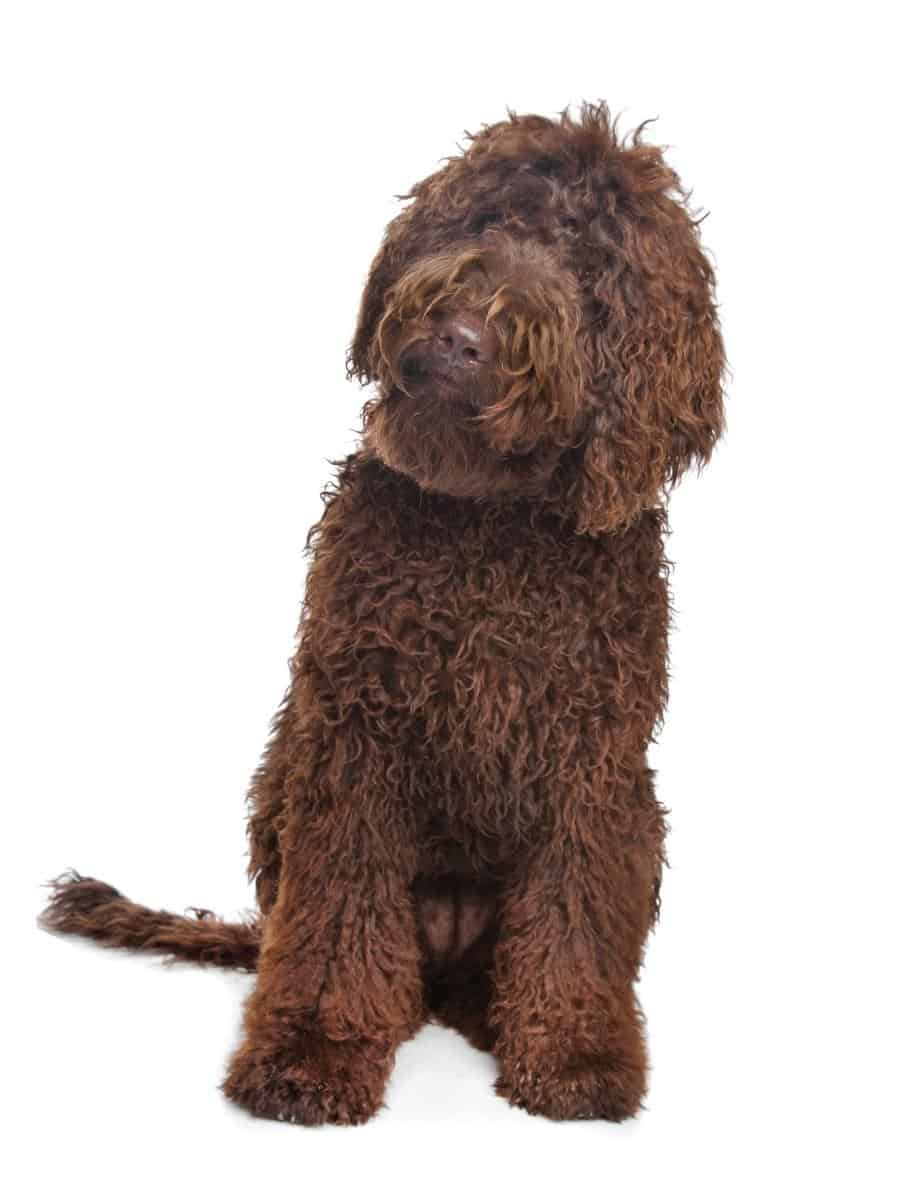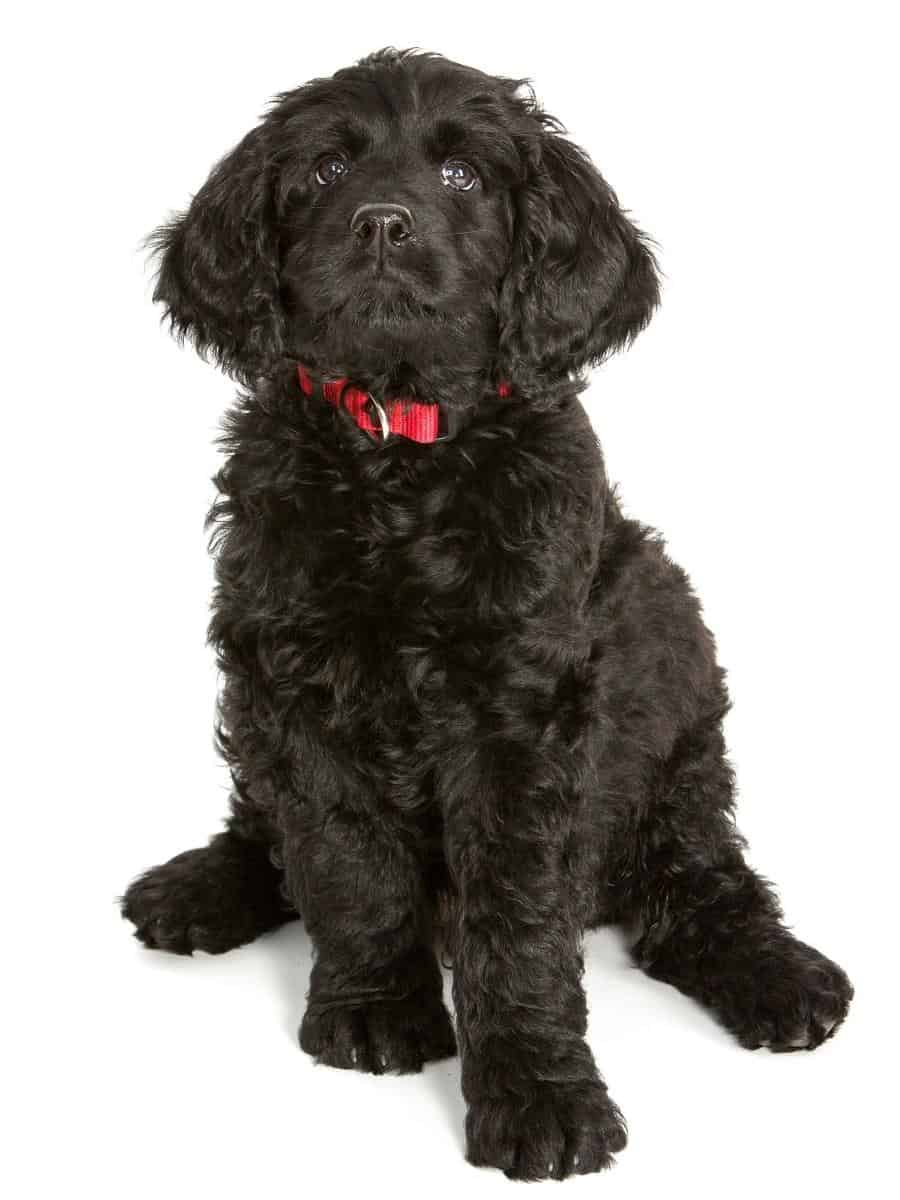Controversy reigns over whether the Australian Wally Conron pioneered Labrador and Poodle crossbreeding in the late 1980s or if Labradoodles already existed in the US by the 1950s. Whichever way the controversy finally settles, the fact is Labradoodles have become widely popular. So what Labradoodle pros and cons should you consider before buying?
Labradoodles are good family dogs with high intelligence, trainability, and warm friendliness towards family, children, and other dogs. Thanks to their Poodle parents, they come in varied sizes, coat types, and colors. However, they are costly, need frequent grooming, and can inherit eye problems.
Since owning a good dog comes with the responsibility of providing proper care, learning about the Labradoodle’s advantages and disadvantages can help you provide the best of care to your Labrador Poodle mix.
This article discusses 11 Labradoodle pros and cons that are a must-learn before you bring home your pet. Let’s get straight to the details!

What Are the Pros and Cons of a Labradoodle?
There is a widespread belief in today’s dog-loving society that mixed breed dogs are better than purebred dogs in many ways, including being healthier and smarter.
While the jury is still out on both issues, there’s no doubt that Labradoodles and other mixed-breed dogs come with many good qualities. But Labradoodles also have some limits.
The primary pro of Labradoodles is that they are extremely smart dogs with plenty of love to give to family, children, and other dogs in the home. The main con about Labradoodles is that they require plenty of grooming.
Besides their intelligence and the grooming task, there are other Labradoodle pros and cons whose knowledge will help you know exactly what you are bargaining for when you bring home this breed.
Below is a list summary of Labradoodle pros and cons discussed in the rest of the article:
| Labradoodle Pros | Labradoodle Cons |
|---|---|
| Labradoodles vary in size | Well-bred Labradoodles can be costly |
| Labradoodles are smart hybrid dogs | They have high coat grooming needs |
| They are excellent family dogs | Labradoodle can inherit genetic health conditions |
| Labradoodles are low-allergen dogs | Labradoodles are high-energy dogs |
| Labradoodles come in many coat colors | |
| Labradoodles are good service dogs | |
| They are easier to predict than other crossbreeds |

Labradoodle Pros
Compared to purebred Labradors and Poodles, Labradoodles inherit genes from a wider pool, thanks to two different parent breeds. This also means they come with better qualities if they inherit a double advantage for a particular characteristic or trait from both parents.
Let’s discuss the pros you should explore when considering a Labradoodle for a pet.
Labradoodle Vary in Size
Labradors have a standard size of 21.5″ – 24.5″ (54.6 – 62.2 cm) height and 55 – 80 lbs (24.9 – 36.3 kg) weight. On the other hand, Poodles can vary in size depending on whether they belong to the Standard, Miniature, or Toy types.
While it is true that most Labradoodles are a crossbreed of a Labrador and a Standard Poodle, some breeders also use Miniature and Toy Poodles for the Labrador Poodle mix. This means that Labradoodle sizes can vary depending on which type you breed with a Labrador.
According to the Australian Labradoodle Association, here’s what to expect from crossbreeding a Labrador and each of the 3 types of Poodles:
| Crossbreed | Height | Weight |
| Labrador + Standard Poodle | 21-24″ (53 – 63 cm) | 9.5 – 13.6 lb (21 – 30 kg) |
| Labrador + Miniature Poodle | 17-20″ (43 – 52 cm) | 5.9 – 9.0 lb (13 – 20 kg) |
| Labrador + Toy Poodle | 14-16″ (35.42 – 40.64 cm) | 3.2 – 5.9 lb (7 – 13 kg) |
Depending on your preferred size, you can use these size standards to locate breeders who have Labradoodles bred from a Labrador and the Poodle type that’s likely to produce your preferred size.
Learn All About The Labradoodle In This Video…
Labradoodles Are Smart Hybrid Dogs
A hybrid dog is a crossbreed of two purebred dogs. They are also known as ‘designer dogs.’ People crossbreed dogs to obtain better versions of the parent breeds in physical and personality traits.
As a general rule, crossbreed dogs inherit genes from both parents, determining their unique physical and personality traits. It is expected that crossbreeding two smart dogs will produce an equally smart hybrid, and that’s the case with Labradoodles.
Both Labrador Retrievers and Poodles belong to the category of the ‘brightest dogs’ which means they are easy to train and obey commands promptly.
Surprisingly, you could also get a Labradoodle that’s more intelligent than their already smart parents. Going by the Institute of Canine Biology, crossbreeding can result in genetic variation that creates a new gene combination with traits that exceed those of their parents.
Labradoodles Are Excellent Family Dogs
Most people bring dogs to their homes as pets and family members. As such, these pets must meet some basic characteristics associated with good family dogs.
Labradors and Poodles are highly rated on all the characteristics of good family dogs, which deductively means Labradoodles also make good family dogs. You can read more about the loving Lab in this article, Are Labradors Good Family Dogs: 17 Things to Know.
Below is a summary of Labrador and Poodle ratings for four primary characteristics of family dogs, going by their rating on the AKC standards for the two breeds:
| Breed | Affectionate with Family | Good with Children | Good with other Dogs | Playful | Easily Trainable |
| Poodle | 5/5 | 5/5 | 3/5 | 5/5 | 5/5 |
| Labrador Retriever | 5/5 | 5/5 | 5/5 | 5/5 | 5/5 |
Going by these ratings, your Labradoodle is most likely to reflect the parents by scoring high on all characteristics of good family dogs, probably a little less in ‘being good with other dogs’ if it mainly inherits from their Poodle parent.
Labradoodles Are Low-Allergen Dogs
One of the reasons Labradors and Poodles were originally crossbred was to create a low-shedding dog that could suit people with dog fur allergies.
Labradors are high shedding dogs, while Poodles are non-shedders. You’ll often see Labradoodles rated as non-shedders. That’s majorly true because they will most certainly not have the high-shedding characteristic of Labrador Retrievers. But Labradoodles may not be completely non-shedding as the Poodle, at least not the F1 hybrid Labradoodle.
Whichever way, though, your Labradoodle will be a lower-allergen dog compared to their Labrador parent.
You can expect your Labradoodle to come in one of these 3 coat types:
- The Curly/Wooly Coat: This is found in Labradoodles that inherit more genetic variation for coat type from their Poodle parent. The coat has a wooly texture with loose and easy-to-brush spiraling hairs. Dogs with this type of coat are non-shedding.
- The Fleece Coat: This is common in Labradoodles that inherit 50/50 genetic variance for coat type from each parent. It has a soft texture and can appear in a spiraling curly or straight wavy look. Labradoodle fleece coats shed lightly and are easier to brush.
- The Hair Coat: It is found in Labradoodles that inherit more gene variance for coat type from their Labrador parent. It is common in first-generation Labradoodles. The coat shedding is higher than the other two coat types but lower than in Labrador coats.
Labradoodles Come in Many Colors


While Labradors come in only 3 colors (black, chocolate & yellow), Poodles come in many coat colors. The same is true of Labradoodles, thanks primarily to the variety of coat colors in their Poodle parent.
Possible Labradoodle coat colors include:
- Black: Solid black without any markings.
- Chalk: White that has a chalky-white look when compared to pure white.
- Cream: A creamy coloring with a gold/apricot tint and varied shades.
- Caramel: The color of caramel, a shade between rich gold and deep red.
- Gold/Apricot: The color of the inside of a mature apricot or a rich gold shade running from the hair roots to the outside.
- Chocolate: A dark and rich chocolate color.
- Red: A solid and even rich red that should be evenly distributed from the hair roots.
- Silver: Can be a light bluish-gray or a dark charcoal shade.
- Blue: A dark or average smoky blue.
- Lavender: A smoky lavender-chocolate color that tends toward lilac or pink color.
Other colors of the Labradoodle include café, sable, brindle, parchment (creamy-beige chocolate), phantom (solid base with defined markings), parti (50% white with patches or spots), and abstract (more than 50% of another color with white markings).
Labradoodles Are Good Service Dogs
Apart from creating a hypoallergenic dog, a second reason for the original Labrador Poodle mix was to create a breed with the temperament of a service dog. That explains why Labradoodles are rated good service dogs.
But the Labradoodle’s affectionate nature, attentiveness, trainability, and ability to read their owner’s and family members’ emotions are all traits that make this breed an excellent service dog for persons with special needs.
Labradoodles Are Easier To Predict Than Other Mixed Breeds
One of the cons attributed to mixed breed dogs is that they are hard to predict because, unlike purebreds, they do not have an established standard for physical and temperamental characteristics.
Nonetheless, the popularity of the Labradoodle and the breed’s crossbreeding history have contributed to the establishment of a Labradoodle breed standard by the Australian Labradoodle Association.
Although the AKC does not yet recognize Labradoodles, prospective owners can make reference to the breed standard established by the Australian Labradoodle Association for an idea of what to expect of their pet.
Labradoodle Cons
Despite the advantages of the Labradoodle explained above, these dogs can also have a few disadvantages. Knowing about the Labradoodle cons will help you determine if the Labrador Poodle mix is meant for you.

Well-Bred Labradoodles Can Be Costly
Since the initiation of Labrador Poodle mix breeding, Labradoodles have grown in popularity. This has not only seen them become frequent family pets in US homes, but their popularity has also led to an inflated price.
A quick search through the websites of Labradoodle breeders in the US with OFA and Australian Labradoodle Association of America memberships revealed that prices range from around $2,300 to $3,500.
Most breeders list their puppies for $3,000. Also, most breeders include an additional State Sales Tax value above their usual pricing.
It is possible to find low-priced Labradoodles on online listing websites like puppyfinder.com where I found pups listed at $400 and $500. However, while it was possible to find plenty of info on the Labradoodle breeding process from breeder websites, this was not always the case with the online listing website.
Low-priced Labradoodles without adequate info on the breeding process could trigger that hunch you and I have; “cheap can sometimes be expensive,” especially when it comes to mixed canine breeding.
Related: Mixed Breed Dogs vs. Purebreds: Who Is More Expensive?
Labradoodles Have High Coat Grooming Needs
Because they inherit part of the curly hair of the Poodle and the shedding fur of the Labrador, Labradoodles have high grooming needs.
If your Labradoodle comes in a curly coat, daily brushing is essential to keep the hairs from matting. Fleece coats should also be brushed daily and are easier to comb than curly coats.
Hair coats can be managed with alternate days of brushing to keep the coats sheen and remove loose hairs.
Labradoodles Can Inherit Parent-Dogs Genetic Health Conditions
All dogs, whether purebred or mixed breeds have some risks for health conditions. While proper care through nutrition, exercise, and regular vet visits is vital to keep your pet healthy, susceptibility to certain diseases can be inherited from parents. This is also true for crossbreeds like Labradoodles.
Labradors are prone to diseases such as:
- Hip and elbow dysplasia
- Eye diseases like progressive retinal atrophy
- Exercise-induced collapse (EIC)
- Centronuclear Myopathy
- Thyroid disease
- The dilute gene
Poodles are especially prone to hip dysplasia and eye diseases.
It appears that Labradoodles also inherit some of these disease risks from their parents, especially hip and elbow dysplasia and eye conditions.
A study review indicated that the Labrador Poodle mix has a higher prevalence of multifocal retinal dysplasia than what is recorded in the parent breeds.
As such, it is recommended that breeders do the necessary screening for hereditary eye disease before breeding.

Labradoodles Are High-Energy Dogs
Labradoodles inherit their high-energy nature from both their Poodle and Labrador parents.
While a high-energy dog is good news for someone who has the time and vigor to provide 1-2 hours of exercise daily for their Labrador and Poodle mix, this may not be the case for people who work all day or have physical limits to an active life.
Considering Labradoodles easily win the bet for good family or service dogs and that anyone would be happy to own such a dog, owning the breed without the time or physical quality for daily exercise could mean an extra cost. That’s because you’ll need to hire the services of a trainer or dog walker daily.
Final Thoughts
Labradoodles are among the most popular mixed-breed dogs in today’s world of dog lovers. While owners will enjoy the friendly nature and attractive looks of their Labrador Poodle mix, they also need to learn about the dog’s care needs and possible genetic health conditions to provide proper care.
The Labradoodle pros and cons discussed in the article should sort out any doubts about whether the mixed breed is a good canine choice for you.





